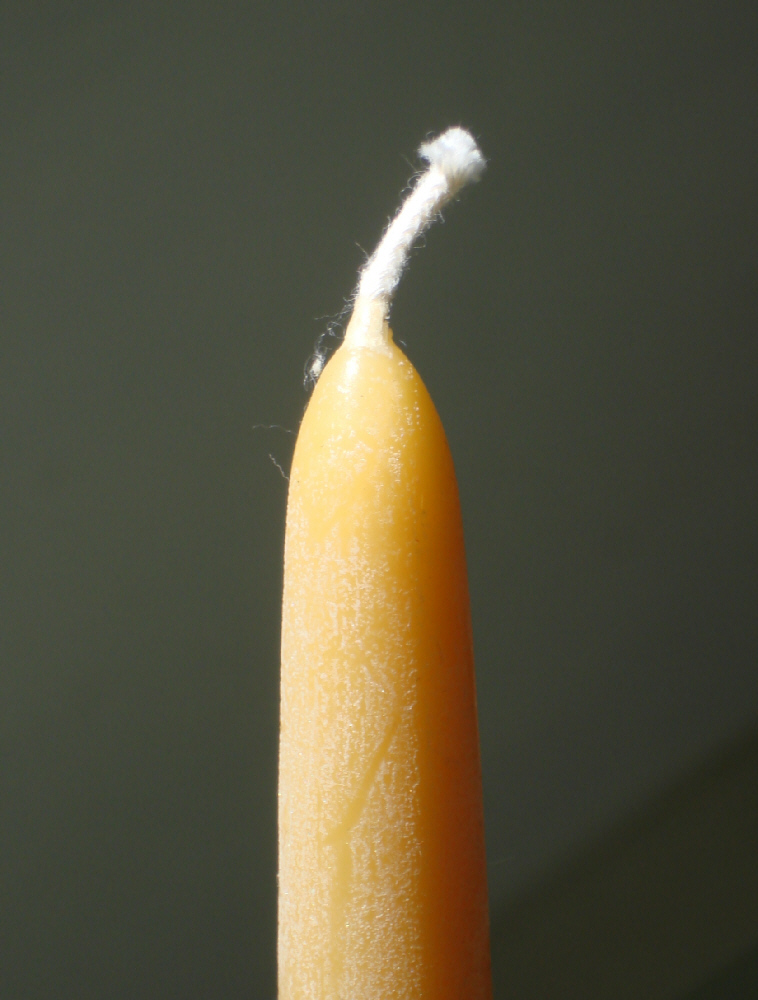Candle Wick on:
[Wikipedia]
[Google]
[Amazon]
 A candle wick is usually a braided cotton that holds the flame of an oil lamp or
A candle wick is usually a braided cotton that holds the flame of an oil lamp or

 A candle wick is usually a braided cotton that holds the flame of an oil lamp or
A candle wick is usually a braided cotton that holds the flame of an oil lamp or candle
A candle is an ignitable wick embedded in wax, or another flammable solid substance such as tallow, that provides light, and in some cases, a fragrance. A candle can also provide heat or a method of keeping time.
A person who makes candle ...
. A candle wick works by capillary action, conveying ("wicking") the fuel to the flame. When the liquid fuel, typically melted candle wax, reaches the flame it then vaporizes and combusts. The candle wick influences how the candle burns. Important characteristics of the wick include diameter, stiffness, fire-resistance, and tethering.
Wick types
Candle wicks are normally made out of braidedcotton
Cotton is a soft, fluffy staple fiber that grows in a boll, or protective case, around the seeds of the cotton plants of the genus '' Gossypium'' in the mallow family Malvaceae. The fiber is almost pure cellulose, and can contain minor pe ...
.Franz Willhöft and Rudolf Horn "Candles" in Ullmann's Encyclopedia of Industrial Chemistry, 2000, Wiley-VCH, Weinheim. Wicks are sometimes braided flat, so that as they burn they also curl back into the flame, thus making them self-consuming. Prior to the introduction of these wicks specialty scissors were used to trim the excess wick without extinguishing the flame.
Large diameter wicks typically result in a larger flame, a larger pool of melted wax, and the candle burning faster.
In tealight
A tealight (also tea-light, tea light, tea candle, or informally tea lite, t-lite or t-candle) is a candle in a thin metal or plastic cup so that the candle can liquefy completely while lit. They are typically small, circular, usually wider than ...
s the wick is tethered to a piece of metal to stop it from floating to the top of the molten wax and burning before the wax does. Candles designed to float in water require not only a tether for the wick, but also a seal on the bottom of the candle to prevent the wick from wicking water and extinguishing the flame.
In some birthday candles, the wick is a stub. This limits how long the candle can burn.
The Japanese Wa-Rosoku candle uses a hollow cored wick composed of Japanese paper ( Washi) and the pith of rushes.
Wicks can be made of material other than string or cord, such as wood and (historically) even asbestos, although they are rare. The cotton of tampons can be used as wicks for oil lamps in wilderness survival situations.

Stiffeners
Fine wire (such as copper) can be included in the wick. This provides two advantages: it makes the wick more rigid, letting it stand further out of the liquid wax, and it conducts heat downward, melting the wax more readily. The latter is particularly important in candles made of harder wax. Stiffeners were once made oflead
Lead is a chemical element with the symbol Pb (from the Latin ) and atomic number 82. It is a heavy metal that is denser than most common materials. Lead is soft and malleable, and also has a relatively low melting point. When freshly cut, ...
, but these have been banned in the US for several years by the Consumer Product Safety Commission, due to the concerns about lead poisoning. Other core stiffeners, such as paper and synthetic fibers, may also be used. The CPSC was petitioned to ban candle wicks containing lead cores and candles with such wicks by Public Citizen, the National Apartment Association, and National Multi Housing Council on February 20, 2001. The ban against manufacturing, importing, or selling candles in the US with lead wicks became effective in October 2003.
Pretreatments of wicks
Virtually all wicks are treated with various flame-resistant solutions in a process known as mordanting. Without mordanting the wick would be destroyed by the flames and the flow of melted wax to the flame would cease. Beyond that, wicks can be treated with substances to improve the color and brightness of the flame, provide better rigidity to keep the wick out of the melted wax, and improve the flow of that wax up the wick. Common treatments areborax
Borax is a salt (ionic compound), a hydrated borate of sodium, with chemical formula often written . It is a colorless crystalline solid, that dissolves in water to make a basic solution. It is commonly available in powder or granular form ...
and salt which are dissolved in water in which the wicks are soaked.
See also
*Fuse (explosives)
In an explosive, pyrotechnic device, or military munition, a fuse (or fuze) is the part of the device that initiates function. In common usage, the word fuse is used indiscriminately. However, when being specific (and in particular in a milit ...
References
External links
{{wiktionary, wick Wick